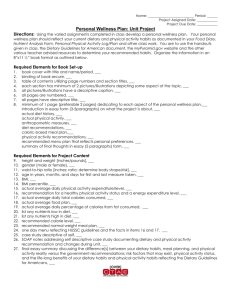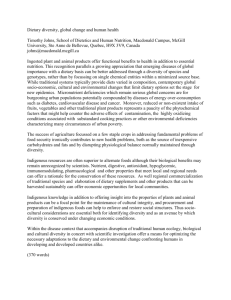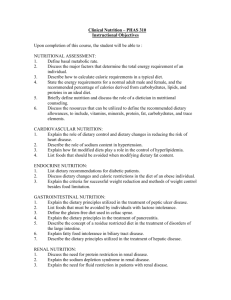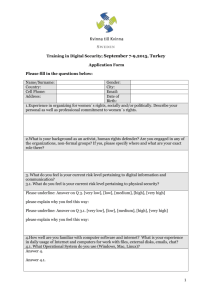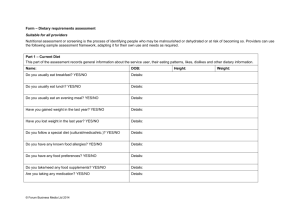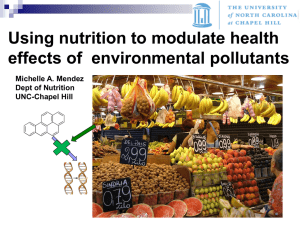A Comparison of Dietary Trends among Racial and Socioeconomic
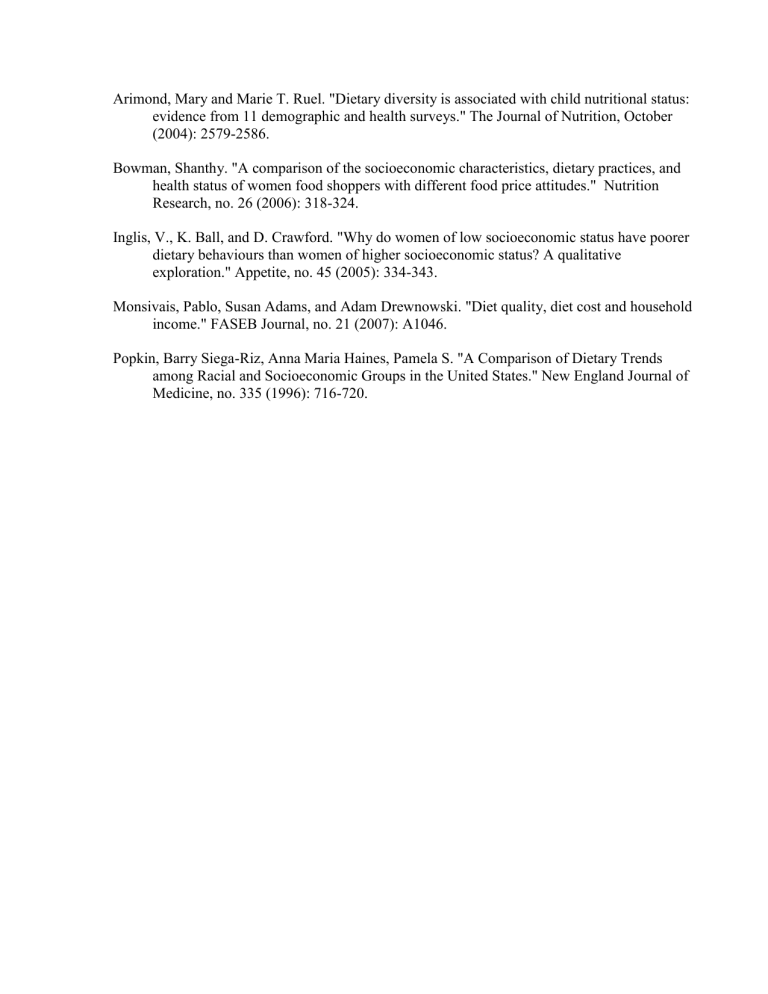
Arimond, Mary and Marie T. Ruel. "Dietary diversity is associated with child nutritional status: evidence from 11 demographic and health surveys." The Journal of Nutrition, October
(2004): 2579-2586.
Bowman, Shanthy. "A comparison of the socioeconomic characteristics, dietary practices, and health status of women food shoppers with different food price attitudes." Nutrition
Research, no. 26 (2006): 318-324.
Inglis, V., K. Ball, and D. Crawford. "Why do women of low socioeconomic status have poorer dietary behaviours than women of higher socioeconomic status? A qualitative exploration." Appetite, no. 45 (2005): 334-343.
Monsivais, Pablo, Susan Adams, and Adam Drewnowski. "Diet quality, diet cost and household income." FASEB Journal, no. 21 (2007): A1046.
Popkin, Barry Siega-Riz, Anna Maria Haines, Pamela S. "A Comparison of Dietary Trends among Racial and Socioeconomic Groups in the United States." New England Journal of
Medicine, no. 335 (1996): 716-720.
A comparison of the socioeconomic characteristics, dietary practices, and health status of women food shoppers with different food price attitudes.
Authors:
Bowman, Shanthy A.1 bowmans@ba.ars.usda.gov
Source:
Nutrition Research; Jul2006, Vol. 26 Issue 7, p318-324, 7p
Document Type:
Article
Subject Terms:
*CONSUMERS -- Attitudes
*FOOD prices
*HEALTH surveys -- United States
*NUTRITION
*WOMEN consumers
*SOCIOECONOMIC factors
Geographic Terms:
UNITED States
Abstract:
Abstract: A person's attitude toward food price could influence food purchase decisions and, consequently, impact diet quality. The aim of the study was to compare soicoeconomic, dietary, and health status of women food shoppers who considered food price very important (n = 1322) with those of women who did not consider food price very important (n = 1272). These women planned and prepared their household meals. Data from US Department of Agriculture's Diet and Health Knowledge Survey,
1994 to 1996, and Continuing Survey of Food Intake by Individuals, 1994 to 1996, were used. The socioeconomic characteristics, dietary intakes, fat reduction practices, and health status were estimated. A priori, pairwise mean comparisons, at α = .05 level of significance, were made. Food price was very important to 46.8% of women. More African-American and Hispanic women food shoppers were likely to consider food price very important when buying food. The women who considered food price very important were more likely to live in low-income, food-insecure households; receive food stamps; have low education; rent and not own homes; and be employed as service workers. They consumed 17 kJ less energy. Yet, the energy density of their diet was 11 kJ/kg more than that of the other group. They ate a low amount of relatively high-price foods like nonstarchy vegetables and drank more sweetened fruit drinks that are an inexpensive source of energy. A low percentage of them adopted dietary fat reduction strategies and read food labels. They are more likely to be overweight and have health conditions such as high blood pressure, heart disease, and diabetes than the others. Dietitians working with low-income food shoppers should address cost-effective ways to buy seasonally available fruits and vegetables and promote dietary fat reduction strategies. [Copyright 2006 Elsevier]
Copyright of Nutrition Research is the property of Elsevier Science Publishing Company, Inc. and its content may not be copied or emailed to multiple sites or posted to a listserv without the copyright holder's express written permission. However, users may print, download, or email articles for individual use. This abstract may be abridged. No warranty is given about the accuracy of the copy. Users should refer to the original published version of the material for the full abstract. (Copyright applies to all
Abstracts)
Author Affiliations:
1U.S. Department of Agriculture—Agricultural Research Service, Beltsville Human Nutrition
Research Center, Beltsville, MD 20705-2350, USA
ISSN:
0271-5317
DOI:
10.1016/j.nutres.2006.06.012
Accession Number:
22134791
How do socio-economic status (SES), perceived economic barriers and nutritional benefits affect quality of dietary intake among US adults?
Authors:
Beydoun, May A.1
Youfa Wang1
Source:
FASEB Journal; Apr2007, Vol. 21 Issue 6, pA1063-A1063, 1/5p
Document Type:
Article
Subject Terms:
*DIET
*FOOD prices
*NUTRITION
*SOCIAL status
Geographic Terms:
UNITED States
Abstract:
We examined independent effects of SES, perceived barriers of food price (PBFP) and benefits of diet quality (PBDQ) on diet quality indicators and indices (DQI), across gender and ethnicity using nationally representative data from the Continuing Survey of Food Intakes by Individuals (CSFII) and Diet and
Health Knowledge Survey (DHKS) 1994-96 for 4,356 individuals aged 20-65 y. Diet was assessed using two 24-hour recalls. By principal components method, SES was constructed with household income per capita and education; and PBDQ, using an 11-item scale. PBFP is the ratio of importance of food price score relative to nutrition. Several DQ1 indicators and indices were considered. PBDQ z-score improved diet quality ( β =-31 for energy, -0.34 for fat (% of energy), and 0.37 for fiber p<0.05). SES z-score among Whites, unlike African-Americans, reduced fat intake by β =-0.71 (p<0.05) and saturated fat by
β =-0.43 (p<0.05) with a significant SESxethnicity interaction. SES positively associated with fiber intake and was significantly stronger among women ( β =0.95 vs. 0.72, p<0.05). Structural equation models revealed significant mediation of SES effects on diet quality through PBFP but not through PBDQ
(mediation proportion>10%) for energy, total fat, sodium and sugar intakes. In conclusion, the effect of
SES on diet quality varied by ethnicity and gender, and there was mediation of the effect of SES on diet quality by PBFP. [ABSTRACT FROM AUTHOR]
Copyright of FASEB Journal is the property of Federation of American Society for Experimental
Biology and its content may not be copied or emailed to multiple sites or posted to a listserv without the copyright holder's express written permission. However, users may print, download, or email articles for individual use. This abstract may be abridged. No warranty is given about the accuracy of the copy. Users should refer to the original published version of the material for the full abstract. (Copyright applies to all
Abstracts)
Author Affiliations:
1Center for Human Nutrition, Department of International Health, Johns Hopkins School of Public
Health, 615 N Wolfe st., Baltimore, MD, 21205
ISSN:
0892-6638
Accession Number:
25598562
Why do women of low socioeconomic status have poorer dietary behaviours than women of higher socioeconomic status? A qualitative exploration.
Authors:
Inglis, V. vinglis@deakin.edu.au
Ball, K.1
Crawford, D.1
Source:
Appetite; Dec2005, Vol. 45 Issue 3, p334-343, 10p
Document Type:
Article
Subject Terms:
*NUTRITION -- Requirements
*PUBLIC health
*SOCIAL status
Geographic Terms:
AUSTRALIA
NAICS/Industry Codes525120 Health and Welfare Funds
Abstract:
Abstract: In developed countries, persons of low socioeconomic status (SES) are generally less likely to consume diets consistent with dietary guidelines. Little is known about the mechanisms that underlie
SES differences in eating behaviours. Since women are often responsible for dietary choices within households, this qualitative study investigated factors that may contribute to socioeconomic inequalities in dietary behaviour among women. Semi-structured interviews were conducted with 19 high-, 19 mid- and 18 low- SES women, recruited from Melbourne, Australia, using an area-level indicator of SES. An ecological framework, in which individual, social and environmental level influences on diet were considered, was used to guide the development of interview questions and interpretation of the data.
Thematic analysis was undertaken to identify the main themes emerging from the data. Several key influences varied by SES. These included food-related values such as health consciousness, and a lack of time due to family commitments (more salient among higher SES women), as well as perceived high cost of healthy eating and lack of time due to work commitments (more important for low SES women).
Reported availability of and access to good quality healthy foods did not differ strikingly across SES groups. Public health strategies aimed at reducing SES inequalities in diet might focus on promoting healthy diets that are low cost, as well as promoting time-efficient food preparation strategies for all women. [Copyright 2005 Elsevier]
Copyright of Appetite is the property of Academic Press Inc. and its content may not be copied or emailed to multiple sites or posted to a listserv without the copyright holder's express written permission.
However, users may print, download, or email articles for individual use. This abstract may be abridged.
No warranty is given about the accuracy of the copy. Users should refer to the original published version of the material for the full abstract. (Copyright applies to all Abstracts)
Author Affiliations:
1School of Exercise and Nutrition Sciences, Deakin University, Burwood, VIC, Australia
ISSN:
0195-6663
DOI:
10.1016/j.appet.2005.05.003
Accession Number:
19045685
Arimond, Mary, and Marie T. Ruel. "Dietary diversity is associated with child nutritional status: evidence from 11 demographic and health surveys. " The Journal of Nutrition. 134.10 (Oct 2004):
2579(7). Health Reference Center Academic. Gale. Southwestern University. 27 Sept. 2007
<http://find.galegroup.com/itx/infomark.do?&contentSet=IAC-
Documents&type=retrieve&tabID=T002&prodId=HRCA&docId=A123580922&source=gale&userGrou pName=txshracd2554&version=1.0>.
Abstract:
Simple indicators reflecting diet quality for young children are needed both for programs and in some research contexts. Measures of dietary diversity are relatively simple and were shown to be associated with nutrient adequacy and nutritional status. However, dietary diversity also tends to increase with income and wealth; thus, the association between dietary diversity and child nutrition may be confounded by socioeconomic factors. We used data from 11 recent Demographic and Health Surveys (DHS) to examine the association between dietary diversity and height-for-age Z-scores (HAZ) for children 6-23 mo old, while controlling for household wealth/ welfare and several other potentially confounding factors.
Bivariate associations between dietary diversity and HAZ were observed in 9 of the 11 countries. Dietary diversity remained significant as a main effect in 7 countries in multivariate models, and interacted significantly with other factors (e.g., child age, breast-feeding status, urban/ rural location) in 3 of the 4 remaining countries. Thus, dietary diversity was significantly associated with HAZ, either as a main effect or in an interaction, in all but one of the countries analyzed. These findings suggest that there is an association between child dietary diversity and nutritional status that is independent of socioeconomic factors, and that dietary diversity may indeed reflect diet quality. Before dietary diversity can be recommended for widespread use as an indicator of diet quality, additional research is required to confirm and clarify relations between various dietary diversity indicators and nutrient intake, adequacy, and density, for children with differing dietary patterns. J. Nutr. 134: 2579-2585, 2004.
KEY WORDS: * Demographic and Health Surveys (DHS) * dietary diversity * child nutritional status * diet quality * socioeconomic factors
A Comparison of Dietary Trends among Racial and Socioeconomic Groups in the United States.
Authors:
Popkin, Barry M.
Siega-Riz, Anna Maria
Haines, Pamela S.
Source:
New England Journal of Medicine; 9/5/96, Vol. 335 Issue 10, p716-720, 1p
Document Type:
Article
Subject Terms:
*NUTRITION -- Research
Geographic Terms:
UNITED States
NAICS/Industry Codes541710 Research and Development in the Physical, Engineering, and Life
Sciences
Abstract:
Background: There may be dietary differences among racial and socioeconomic groups in the United
States. Methods: Using data from a representative sample of adults, we compared dietary trends among blacks and whites of varying socioeconomic status. We developed comparable measures of diet and of the consumption of macronutrients and food groups for 6061 participants in the 1965 Nationwide Food
Consumption Surveys, 16,425 in the 1977–1978 Nationwide Food Consumption Surveys, and 9920 in the 1989–1991 Continuing Survey of Food Intake by In-dividuals (all conducted by the U.S.
Department of Agriculture). The primary outcome was the score (range, 0 to 16) on the Diet Quality
Index, a composite of eight food-and-nutrient–based recommendations from the National Academy of
Sciences. A score of 4 or less was considered to indicate a relatively more healthful diet, and a value of 10 or more a relatively less healthful diet. Results: Overall dietary quality improved in all groups, from a mean Diet Quality Index score of 7.4 in 1965 to 6.4 in 1989–1991. In 1965, blacks of low socioeconomic status and, to a lesser extent, whites of low socioeconomic status had better diets than whites of high socioeconomic status. By the 1989–1991 survey, the differences among racial and socioeconomic groups had narrowed. In 1965, 9.3 percent of whites of low socioeconomic status, 16.4 percent of blacks of low socioeconomic status, and 4.7 percent of whites of high socioeconomic status had mean scores of 4 or less. In the 1989–1991 survey, the respective percentages were 19.9, 23.5, and
20.0. Fat consumption decreased in all groups. The consumption of fruits and vegetables varied little over time, except for an increase among blacks of medium and high socioeconomic status. The consumption of grains and legumes increased over time among whites of medium... [ABSTRACT FROM AUTHOR]
Copyright of New England Journal of Medicine is the property of New England Journal of Medicine and its content may not be copied or emailed to multiple sites or posted to a listserv without the copyright holder's express written permission. However, users may print, download, or email articles for individual use. This abstract may be abridged. No warranty is given about the accuracy of the copy. Users should refer to the original published version of the material for the full abstract. (Copyright applies to all
Abstracts)
Full Text Word Count:
2979
ISSN:
0028-4793
DOI:
10.1056/NEJM199609053351006
Accession Number:
24935031
Title:
Diet quality, diet cost and household income.
Authors:
Monsivais, Pablo1
Adams, Susan1
Drewnowski, Adam1
Source:
FASEB Journal; Apr2007, Vol. 21 Issue 6, pA1046-A1046, 1/5p
Document Type:
Article
Subject Terms:
*COST & standard of living
*DIET
*FOOD consumption
*FOOD prices
*INCOME
*POOR
Abstract:
Energy-dense, nutrient-poor diets are disproportionately consumed by low-income populations. This bias might be due to the fact that high energy density (ED) foods provide dietary energy more cheaply than low ED foods. The hypothesis that diet cost is a key variable linking low income to low diet quality the has been difficult to test in part because existing data sources do not provide diet quality measures, diet cost and income data for the same individuals. We explored the association between diet quality, diet cost and household income in a sample of 160 adult men and women with mean age 40y and median household income $55-$64.9k. Subjects' dietary intakes were assessed using a novel food-frequency
questionnaire-based instrument that yields estimated daily diet costs in addition to standard estimates of nutrient and energy intakes. Household income was reported in a separate demographic questionnaire.
Dietary ED was calculated by dividing dietary energy by total weight of food consumed. Analyses of variance revealed that the lowest quintile of diet cost was associated with significantly higher dietary ED.
Additionally, lowest household incomes were significantly associated with higher dietary ED. These findings support the hypothesis that incomes and food prices are key factors influencing the diet quality of individuals. [ABSTRACT FROM AUTHOR]
Copyright of FASEB Journal is the property of Federation of American Society for Experimental
Biology and its content may not be copied or emailed to multiple sites or posted to a listserv without the copyright holder's express written permission. However, users may print, download, or email articles for individual use. This abstract may be abridged. No warranty is given about the accuracy of the copy. Users should refer to the original published version of the material for the full abstract. (Copyright applies to all
Abstracts)
Author Affiliations:
1Center for Public Health Nutrition, School of Public Health and Community Medicine, Univeristy of
Washington, 305 Raitt Hall, University of Washington, Box 353410, Seattle, WA, 98195
ISSN:
0892-6638
Accession Number:
25598482
DIET PATTERNS AND DETERMINANTS IN MINORITY COMMUNITIES (574.1-574.8).
Source:
FASEB Journal; 3/7/2005, Vol. 19 Issue 5, pA977-A978, 2p
Document Type:
Abstract
Subject Terms:
*ABSTRACTS
*BIOLOGY, Experimental
*CALCIUM in human nutrition
*CONGRESSES & conventions
*DIET
*FOOD prices
*MINORITIES
*PREGNANCY -- Nutritional aspects
Geographic Terms:
CALIFORNIA
SAN Diego (Calif.)
NAICS/Industry Codes561920 Convention and Trade Show Organizers
Abstract:
Presents abstracts of studies on diet patterns and determinants in minority communities, presented at the Experimental Biology/International Union of Physiological Sciences 2005 congress held in San
Diego, California. "Select to Protect!: Ethnic Differences in Calcium Consumption Among Low-Income
Minority Children and Use of Food Label by Primary Caregivers--Report on the Baseline Data for the
Social Marketing Campaign," by Debra Keenan, Jan Goodman et al.; "Dietary Assessment of Pregnant
(P) or Lactating (L) Arctic Indigenous Women," by Harriet Kuhnlein and Tomoko Nakano; "Effect of
Fruit and Vegetable Cost on Availability in a Multiethnic Sample," by Jamy D. Ard, Renee Desmond et al.
ISSN:
0892-6638
Accession Number:
16931278



